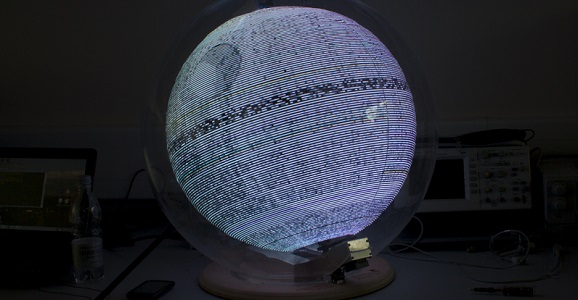Kickstart A Smartphone Hologram Pyramid, Or Just Ogle A Death Star Hologram
This article is more than 2 years old
 Regardless of its appearance, once the flying car has come into the picture, one might say humanity is finally reaching the metaphorical “future.” (Now we just need to figure out how to get that car folded up into a suitcase.) Another good sign of technological transcendence is the advent of holograms entering our everyday lives. And not the “dead musician performing on stage” variety, but one that can be used at home, attached to a tablet or smartphone, or one that projects its images in a globe. And while neither of these products are advanced enough to show off Star Wars distress messages, at least there’s a Death Star involved.
Regardless of its appearance, once the flying car has come into the picture, one might say humanity is finally reaching the metaphorical “future.” (Now we just need to figure out how to get that car folded up into a suitcase.) Another good sign of technological transcendence is the advent of holograms entering our everyday lives. And not the “dead musician performing on stage” variety, but one that can be used at home, attached to a tablet or smartphone, or one that projects its images in a globe. And while neither of these products are advanced enough to show off Star Wars distress messages, at least there’s a Death Star involved.
The POV Globe, seen above depicting one of the most dangerous weapons in fiction, is a project from the School of Electronic & Engineering at the University of Leeds in England. Designed around a Raspberry Pi controller, the Globe uses a ring of RGB LEDs that rotate around the interior at 300 revolutions per minute. The definition isn’t going to impress the sticklers, but this is still a pretty amazing device, and there’s nothing out there quite like it.
Best of all, for some, is that the globe can be controlled by an app downloaded to an iOS device. To me, this is more of a display piece, and perhaps the most complicated picture frame I’d ever own, but I don’t see any way it would impact my daily life. I’m not going to actually watch TV on this thing, but that doesn’t mean I’m not absolutely impressed that it’s possible. Take a look at the video below to see some of the ways the team showed off the Globe’s powers. Beware the Yoshi.
Pretty badass, right? I have to assume the frame rate of the recording makes the Globe look jumpier than it would otherwise. But how about a device that might see a little more everyday use?
Behold the Holho, a hologram generator currently on its way to what will probably be a successful Kickstarter campaign. The Holho doesn’t generate any images itself, but works as an attachment for a smartphone or tablet, allowing for a 3D image to be reflected off of the screen, either into a small pyramid structure or one of two frontal projection devices. Take a look at the Holho promotional video below.
I can’t quite grasp whether you can actually watch movies and things on here, or if it’s limited to the app-created videos, such as those of butterflies and fish. If that’s the case, my interest level drops severely, even though the device looks pretty easy to put together and use, and isn’t quite as expensive as I’d have predicted. But I don’t know why I wouldn’t just use my smartphone or tablet’s screens to do what they’re already meant to do. Give me a holographic device that projects a book’s pages, and also allows for hands-free page-turning.
Also, they could at least make one of these things look like R2-D2 if they wanted to add that extra bit of geek love.












